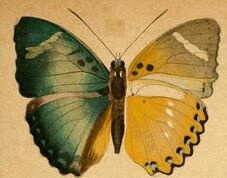Biology:Euphaedra preussi
| Euphaedra preussi | |
|---|---|

| |
| Scientific classification | |
| Domain: | Eukaryota |
| Kingdom: | Animalia |
| Phylum: | Arthropoda |
| Class: | Insecta |
| Order: | Lepidoptera |
| Family: | Nymphalidae |
| Genus: | Euphaedra |
| Species: | E. preussi
|
| Binomial name | |
| Euphaedra preussi Staudinger, 1891[1]
| |
| Synonyms | |
| |
Euphaedra preussi is a butterfly in the family Nymphalidae. It is found in Cameroon, the Central African Republic, the Democratic Republic of the Congo, Angola and Uganda.[2]
Description
E. preussi differs from all the other forms of the subgroup in having a broad white longitudinal band, sometimes tinged with bluish, at the costal margin of the- hindwing beneath, covering the base of this margin and then in cellule 7 extending far beyond the middle; the under surface has no black discal spots and the submarginal spots are small or entirely absent; the subapical band of the forewing is always narrow, in the male often very narrow, of uniform breadth, more or less broken up into spots and white, or in the male greenish; the green or bluish hindmarginal spot on the upperside of the forewing is large, reaching at least to vein 2. preussi Stgr. (42 d). The forewing above sometimes dark green almost throughout, with two black dots in the cell, sometimes deep black transversely across the middle, as is usual in the species of this group; the ground colour of the under surface is very inconstant, varying from greenish to yellowish and ochre-brown; the sub marginal spots are distinct on the hindwing and in cellule 1 b of the forewing. Cameroons to Angola and the Albert Nyanza. -ab. njami Stgr. has the forewing blacker above, not greenish in the apical part, and the under surface dark rust-brown with distinct submarginal spots. Njam-Njam-Land. -ab. njamnjami Stgr. only differs from njami in the entire absence of the submarginal spots on the under surface. Njam-Njam-Land. - ab. olivacea Grunb. [ now species Euphaedra olivacea] has the upper surface uniformly dark except for the white subapical band, without a trace of light or dark submarginal spots on the hindwing and the under surface quite as uniform brownish green with the black cell-spots much reduced. Uganda.-ab. neumanni Rothsch. [now species Euphaedra neumanni ] is distinguished by having on the upper surface an ill-defined yellowish nebulous band, running from the apex of the cell of the forewing to the hindmargin and across the middle of the hindwing, thus restricting the greenish colour; the hindwing with distinct submarginal spots above and beneath; the under surface light grey-green. Abyssinia. [3]
Subspecies
- Euphaedra preussi preussi (Cameroon, Central African Republic, Democratic Republic of the Congo, Angola, Uganda)
- Euphaedra preussi pallida Hecq, 1984 (Democratic Republic of the Congo: Shaba)
Similar species
Other members of the Euphaedra preussi species group q.v.
References
| Wikimedia Commons has media related to Euphaedra preussi. |
- ↑ "Euphaedra Hübner, [1819]" at Markku Savela's Lepidoptera and Some Other Life Forms
- ↑ Afrotropical Butterflies: Nymphalidae - Tribe Adoliadini
- ↑ Aurivillius, [P.O.]C. 1908-1924. In: Seitz, A. Die Grosschmetterlinge der Erde Band 13: Abt. 2, Die exotischen Grosschmetterlinge, Die afrikanischen Tagfalter, 1925, 613 Seiten, 80 Tafeln (The Macrolepidoptera of the World 13).Alfred Kernen Verlag, Stuttgart.
 This article incorporates text from this source, which is in the public domain.
This article incorporates text from this source, which is in the public domain.
Wikidata ☰ Q5410244 entry
 |


